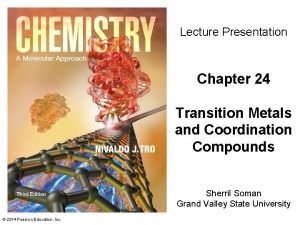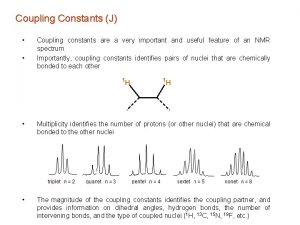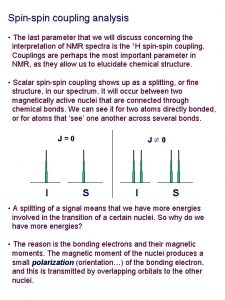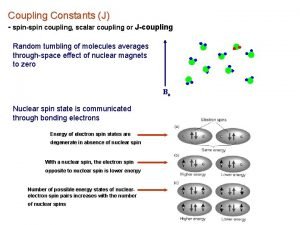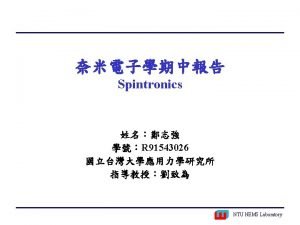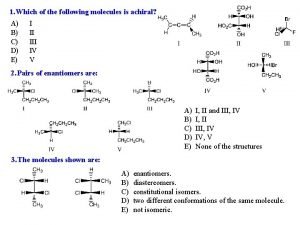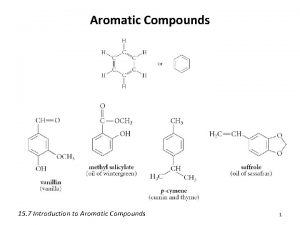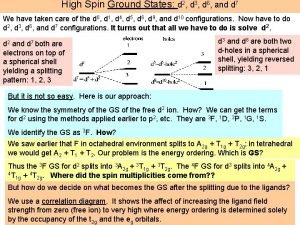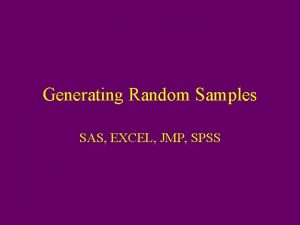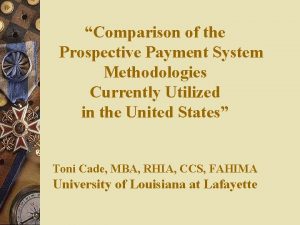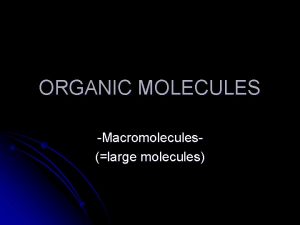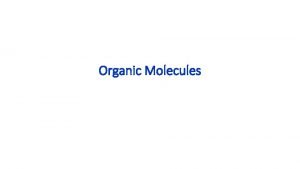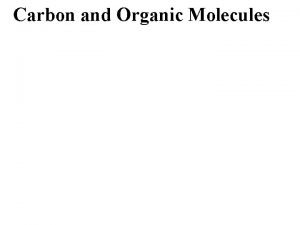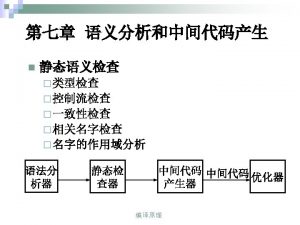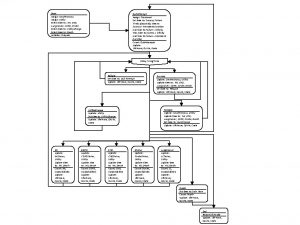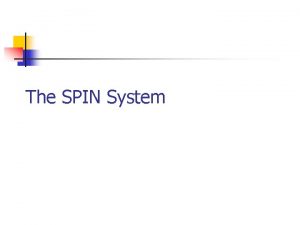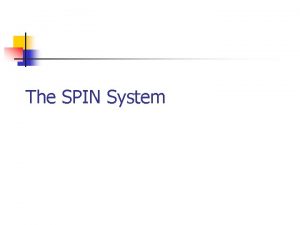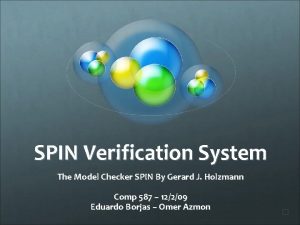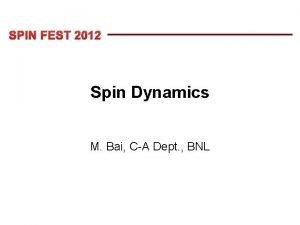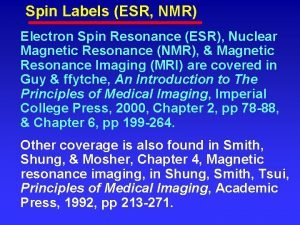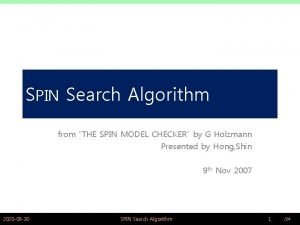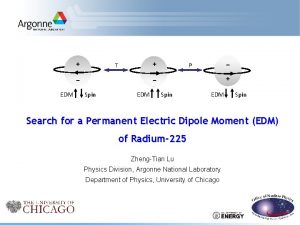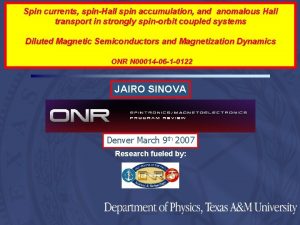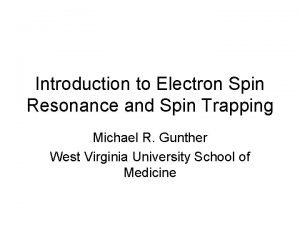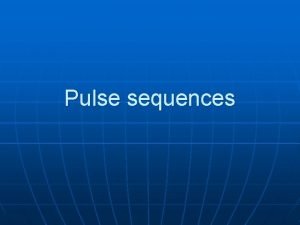Assign Spin System to the Following molecules Assign






















- Slides: 22

Assign Spin System to the Following molecules


Assign Spin System(s) to styrene




NMR Spectrum of p-Xylene (1, 4 -dimethylbenzene) 6 4


NMR Spectrum of 2 -Chloropropanoic Acid COOH 3 1 ~12 ppm offset = 4. 00 ppm 1

Acetophenone (90 MHz) 3 Compare: The ring protons in toluene come at about 7. 2 ppm at the red line. 2 3 deshielded


NMR Spectrum of 1 -iodo-4 -methoxybenzene 3 CHCl 3 impurity 2 2

Identify the Coloured protons as Homotopic, Enantiotopic or Diastereotopic

Homotopic Groups, More Examples This operation is called “rotation about a C 2 axis. ” This means that we rotated the molecule by 1/2 of 360°. Rotation about a C 3 axis means that we rotated the molecule by 1/3 of 360°. Rotation about a C 4 axis means that we rotated the molecule by 1/4 of 360°. Rotation about a C 5 axis means… you get the picture. Note that we can draw the molecule in a flat conformation rather than the chair conformation. This is because the molecule is fluxional, and we are interested in its time-averaged properties. Whenever we rotate about a Cn axis, all the groups that change places are homotopic

Homotopic Groups Homotopic groups are in identical environments. They are related to each other either by a bond rotation or an axis of rotation in the molecule. This means that if we can rotate a bond and get an indistinguishable molecule (i. e. , if you walk out of the room and someone rotates a bond, when you return, you can’t tell that bond has been rotated), or rotate about an axis that runs through the molecule (i. e. , if you walk out of the room and someone rotates the entire molecule, when you return, you can’t tell that molecule has been rotated), then the groups that change place upon rotation are homotopic. Examples: Rotation about the CH 3 -C bond produces a molecule which is indistinguishable in all respects with the original molecule. All the groups or atoms that change places upon rotation, in this case, the three H’s of the methyl group, are homotopic.

Examples of Groups that are Not Homotopic How about the methyl groups in the molecule shown below, are they homotopic? No, they are not homotopic because this molecule does not have a C 2 axis. Rotation about the axis shown produces a molecule which can be distinguished from the starting molecule (if you were to leave the room, have someone apply this rotation, and then return, you’d be able to tell that the molecule was rotated since the methyl groups are now pointing down). They are Enantiotopic – related by reflection through sigma plane!


Examples of Groups that are Not Enantiotopic As we’ve seen, the molecule shown below has a s- plane. So, are the two H’s shown enantiotopic? No! In order for two groups to be enantiotopic, they have to change places with each other by the action of the s- plane. These H’s do not change places with each other, rather they change places with hydrogens across the ring and are enantiotopic with respect to those hydrogens, but not to each other. The two red hydrogens are enantiotopic with respect to each other, and the two blue hydrogens are enantiotopic with respect to each other. The red and blue H‘s are Diastereotopic to each other!

Diastereotopic Groups Diastereotopic groups are in different environments. They are not related to each other by any symmetry element. For example, the red and blue hydrogens in the molecule shown below are not related to each other by any symmetry element. As we saw in the previous slide, there is a mirror plane in the molecule, but it does not interconvert those hydrogens with each other. Another way to look at it is that the red hydrogen is always syn- to the methyl group while the blue hydrogen is always anti- to the methyl group. In the molecule shown below, the red and blue H’s are also not related by any symmetry element, and are, therefore, diastereotopic. Note that it does not matter if we draw the OH with a bold line (i. e. , if we have a single enantiomer) or with a non bold line (if we have a racemic mixture); either way, the carbon bearing that OH is tetrahedral and the carbon cannot be planar, so there are no symmetry elements.

Indicate if the Labeled Groups are Homotopic, Enantiotopic, or Diastereotopic, and if They Must Appear at the Same Chemical Shift

Indicate if the Labeled Groups are Homotopic, Enantiotopic, or Diastereotopic, and if They Must Appear at the Same Chemical Shift Same d Could be different d

 Low spin and high spin complex
Low spin and high spin complex J
J Spin spin coupling
Spin spin coupling Spin spin coupling
Spin spin coupling 優點
優點 Organic molecules vs inorganic molecules
Organic molecules vs inorganic molecules Which molecule is achiral
Which molecule is achiral 4n+2 aromatic rule
4n+2 aromatic rule Conclusion of operating system
Conclusion of operating system Spin operating system
Spin operating system Xap3000
Xap3000 Lfae for d5 weak fields is
Lfae for d5 weak fields is Spin operating system
Spin operating system Did investigator assign exposures
Did investigator assign exposures Ascom unite assign
Ascom unite assign Site:slidetodoc.com
Site:slidetodoc.com Ascom unite assign
Ascom unite assign Library of congress cutter table
Library of congress cutter table Web assign
Web assign Sas random sample
Sas random sample Verilog assign 조건문
Verilog assign 조건문 A computer software program that assign appropriate ms-drgs
A computer software program that assign appropriate ms-drgs Hát kết hợp bộ gõ cơ thể
Hát kết hợp bộ gõ cơ thể
